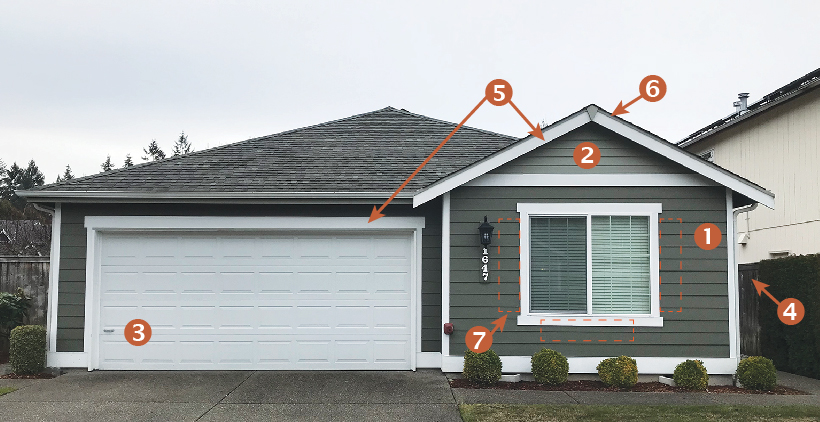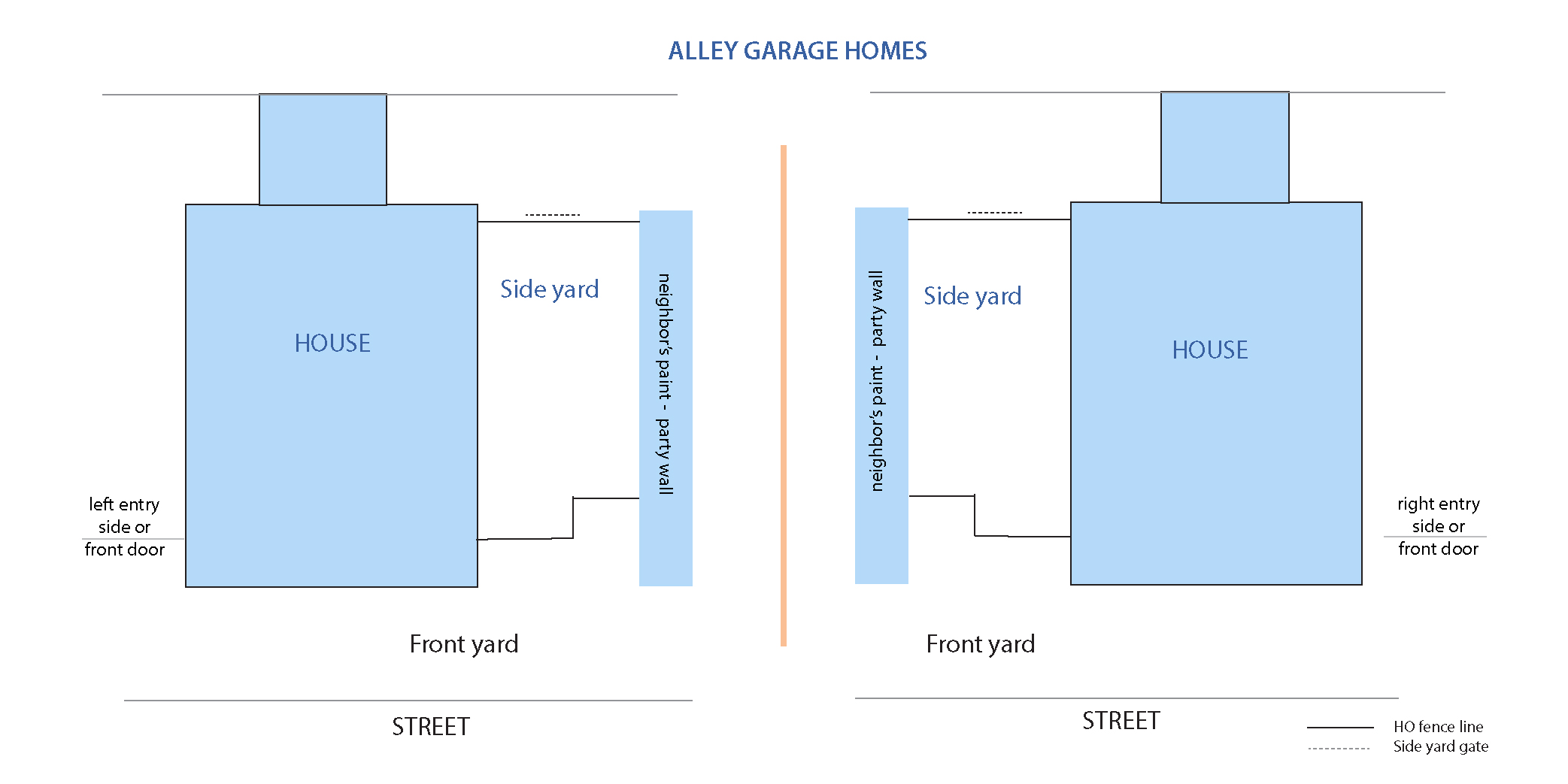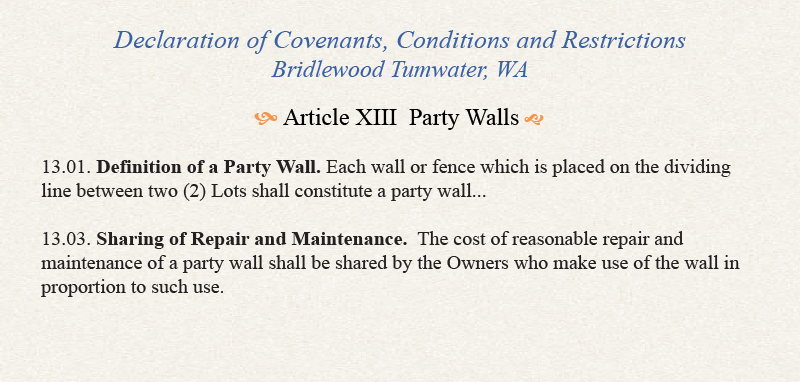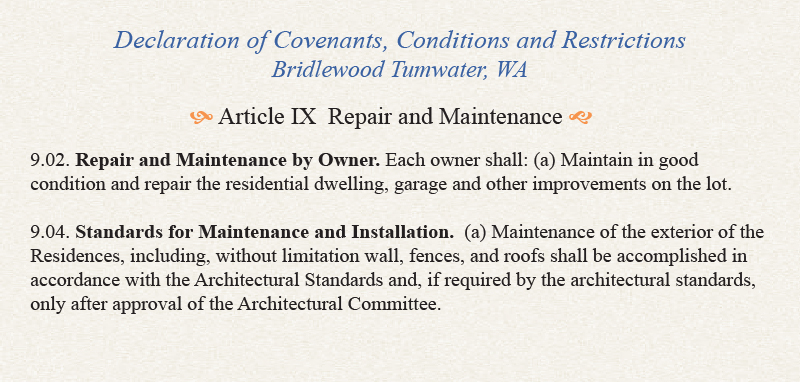- Home
- Bridlewood Owners’ Association Committees
- Architectural Control Cmte
Architectural Control Committee
A home is usually the largest investment in one’s life. Bridlewood’s Architecture Control Committee (ACC) is tasked by the Homeowners Association to help protect the valuation of our community of 211 homes.
As the whole of our neighborhood remains vibrant and updated, so do the investments in our houses and lives.
The ACC has two responsibilities: Reviewing homeowner exterior improvement requests and an annual walk-through of the neighborhood to identify homes which are falling into disrepair.
Click on the tab below for your project type to read the ACC guidelines.
ACC POLICIES and PROCEDURES
WHAT TO EXPECT
ACC requests are turned around in no more than 30 days. If unable to meet this deadline, the request is deemed granted or automatically approved. Every attempt is made to provide a response as soon as possible. However, the turnaround time will vary depending on the size and availability of the ACC Committee.
1. The ACC form is completed and emailed to ACC@Bridlewoodtumwater.com or submit to the Mailbox station.
2. Paint samples must be included for painting projects (even if you are repainting the same colors).
3. Modification requests, such as awnings and trellises, must include drawings and the location of the modification. This is necessary so the ACC chair can verify that the modification is following the Policy and Procedures of the ACC.
4. The ACC chair reviews the request for completeness and may contact the homeowner for clarification or if additional information is needed.
5. The ACC then notifies the homeowner of approval or disapproval.
6. If the application is disapproved, the HO may request a hearing from the board.
GUIDELINES TO EXTERIOR PAINT and REPAIR
Painting projects must have an Architecture Change Committee (ACC) application approved by the ACC Committee before work begins. Neighbor notification is essential in the ACC approval process as the party wall is directly viewed by the neighbor. In addition, access to neighbor property for painting is necessary. Allow 30 days prior to your project date to complete the approval process. Actual response time may vary.

GENERAL PAINTING GUIDELINE
The ACC strives to allow personal expression and individuality while keeping the cohesiveness of the neighborhood.
- The paint palette is limited to four colors excluding the front door, if painted.
- Freshening up paint, such as trim, in the same color does not require approval.
- Paint color cards are to be included with the ACC request.
MAIN BODY of HOUSE and GABLE (1, 2)
You may choose any body and /or gable color you wish with the exceptions of red, shades of red (pink, salmon etc.), bright yellow, orange, lime green, dark purple, black or cranberry/merlot.
The gable may be the same as the body color or a color to coordinate with your color scheme and has the same exceptions as listed above for the house body.
The ACC will evaluate your choice of color to determine if it fits with the rest of the colors in the neighborhood. The ACC reserves the right to negotiate homeowner choices.
GARAGE and FRONT DOORS (3, 4)
Garage doors may also be painted the same color as the body of the house and include the same body exceptions of red, shades of red (pink, salmon etc.), bright yellow, orange, lime green, black or cranberry/merlot. Keep in mind that paint on vinyl tends to peel and you will be responsible for repainting any peeling areas.
Front doors may be stand-alone colors that coordinate with the color scheme, or from the same range of colors in the house palette, including the same as trim colors of black, cranberry/merlot, bright colors, etc.
Replacement garage doors may include windows across the top but must remain essentially the same as the original homes. No barn doors, wooden doors, etc.
PRIMARY and ACCENT TRIM COLORS (5, 6)
Trim color is to coordinate with the body of the house. There are two house trims: the primary fascia trim around windows, doors and gables; and a smaller accent trim for style. Homeowners may paint as one color or two. You may choose from the same color palette, a neutral or a pastel, in either a contrast or complementary shade to the body of the house.
Trim may include red, shades of red (pink, salmon etc.), bright yellow, orange, lime green, dark purple, black or cranberry/merlot.
SHUTTERS AND FLOWER BOXES (7)
If you have installed stationary shutters or flower boxes, include the paint color, using the Trim and Accent guideline.
STREET NUMBERS and WALL PORCH LIGHTS (OTHER)
You may use any street number and porch light styles as long as they fit on the board that currently holds the home address. The board must be painted the same color as the body of the house, and the house number may be any within your four color palette. No ACC form is needed when changing street numbers or lights.
GUTTERS and DOWN SPOUTS
Gutters and downspouts may remain unpainted (white) or painted the body or primary trim color. Please note: Bridlewood gutters are metal. They must be prepped properly, or they will peel, and you may be requested to repaint.
(Updated March, 2023)
GUIDELINES TO FENCE REPLACEMENT
Fence replacement must have an Architecture Change Committee (ACC) application approved by the ACC Committee before work begins. Neighbor notification is important in the ACC approval process as fences are on shared property lines. Allow 30 days prior to your project date to complete the approval process. Actual response time may vary.
MATERIAL: CEDAR
Fences must be replaced with cedar, the same wood used throughout Bridlewood. White or red ceder is acceptable.
STAIN, no PAINT
You may use clear sealer or wood stain on your fence, or leave it natural. For Bridlewood specifications, only clear cedar-colored stain
(not paint) is allowed on your fence side that is visible from the street. You can stain or paint whatever you want on the private interior side. Shared party wall fences may be stained as each side prefers.
Fences along the retention pond and other visible common areas such as those facing on Belmonte or end-of-block homes must remain unstained so they all weather similarly.
Caps for fence posts may be as you like.
FENCE REPAIR
Fence repairs and gate-only replacements do not require an ACC approval. The wood and stain finish must match the other fence guidelines.
WHOSE FENCE IS IT?
Who chooses and pays for the fence? That’s a very neighborly question! The bottom line is you will need to work out the answer between you. However, there is a logical ownership and responsibility.
For homeowners living with an alley garage, you are responsible for all side yard fence between you and the neighbor.

For homeowners with a street side garage, you are fully responsible for the gate side and your back property line fence. The fences extending from the neighbor home and your home to
the back property are shared cost, as defined to be a party wall. You and your neighbor must decide on how to cost it out and the best time to make changes.

Each of the entry side fences will be your neighbor’s responsibility as from their perspective this is their side yard.
Read more about the shared “party wall” and fence line on the Neighbor Notification tab.
(Updated March, 2023)
GUIDELINES TO OTHER ACC PROJECTS
Other ACC projects must have an Architecture Change Committee (ACC) application approved by the ACC Committee before work begins. This may include, but are not limited to, projects that affect the street view and neighbors, such as attached awnings, trellises, flag pole or new permanent light fixtures. Neighbor notification is important in the ACC approval process as some projects may have a significant impact on their views and privacy. Allow 30 days prior to your project date to complete the approval process. Actual response time may vary.
GENERAL GUIDELINE
Front yard new construction requires you to submit an ACC request form. Most of your backyard home improvements are at your own will. However, a few enhancements to your backyard may have an impact on the neighborhood beyond your fence. These are the Other ACC Projects quick guidelines for when to request approval:
- If you can see it easily from the street.
- If it is taller than 12′.
- If your neighbor is likely to complain about change to less privacy, excess light, or noise.
ATTACHED CONSTRUCTION
Awnings are the most often attached construction that require ACC approval. Although constructed in the backyards, since they are often visible by neighbors or from the street view, they fall into our Other ACC projects application. All attached construction, or any construction needing a City of Tumwater permit, is also included here. You will need to work with your contractor for any City permit requirements.
UNATTACHED CONSTRUCTION
Homeowners may install free standing construction. Trellises, sheds, large play equipment and party tents or canopies usually do not require ACC project review. Be mindful of size and
location within your yard, as this might trigger the sight from the street guideline. Anything that may be obstructive to neighbors or street view could be subject to ACC review.
HARDSCAPE and LANDSCAPE
Patios, decks and retaining walls are usually not viewed from the street front so do not require ACC approval, but must be maintained to ACC standards.
Plants and trees do not usually require ACC approval. You are encouraged to review the tree size at maturity for proper placement within your yard and assure they will not encroach on neighbor
lot line, fence or roofs.
NEW PERMANENT LIGHT
If you install new permanent light fixtures or motion lights an ACC form is required. Changing your existing exterior door light fixtures do not. The direction of lighting
along with the intensity are the primary considerations.
FLAGS and YARD ART
You may display flags of your choice as long as not offensive or discriminatory in your flag standard.
Yard statuary and ground banners should be limited to placement in plant beds or along sidewalk so as to not interfere with landscape maintenance. Any items left unsecured is at the risk of the homeowner.
No political, election or advertising signs are allowed.
Also see
U.S. flagpole policy in the Bridlewood library for guidelines.
GUIDELINES TO NEIGHBOR NOTIFICATION
Neighbor Notification is required for all ACC projects: Painting, Fence and Other ACC Projects. Your Architecture Change Committee (ACC)
application includes a notification section and must be approved before work begins.

GENERAL GUIDELINE
At minimum, your shared “party wall” neighbor must be contacted as having been notified of your project for application. An ACC request print form will require an actual signature. The online form is signed by the applicant with an assurance that neighbors have been contacted and the date.
- Contact your neighbor prior to completing your ACC request to notify them of type of project and expected work date.
- Seek out the home owner if you live next door to a residential renter.
- For painting or back yard fence replacement, make arrangements for permission on how and when workers may access the neighbor property. Be sure to address any concerns about animals and workers’ safety.
- Once your project is approved, send a 48 hour reminder to your neighbor before commencing the project.
WHY NOTIFY
You are obligated to contact your neighbors and sign acknowledgment as having fulfilled the notification. Not requesting their participation may result in unwelcome complaints and/or costly remedies later.
The ACC asks you to notify neighbors on both adjacent sides of your home, (if you have them) and across the street if the project has a significant impact of change.
The importance of this step is to advise your neighbors who own the property adjacent, facing or impacted by the improvement to your property line that modifications are proposed. With our Bridlewood common lot line, you are likely to need access to their property in order to complete the work. The ACC recommends you provide at least two (2) weeks notice before the work begins to request access, and send a courtesy reminder two days before work begins.
Homeowners with dogs, unusual work schedules and renters may need this timely heads-up to make the appropriate arrangements.
PARTY WALL
Bridlewood has an unusual zero property line on one side of most lots. This creates a “party wall” i.e., the house wall of one neighbor is part of the “fence” to your side yard. Regardless of street or alley home, the gate side fence is the same side as your party wall neighbor.
This closeness means its a good idea to know who lives next door!
- For painting, you are asked to get neighbor input on the colors you chose. After all, they will be looking at your paint choice every time they look into their side yard. If there are questions
about this process by you or your neighbor, either may contact an ACC committee member or you can note it on the application comments. The neighbor’s input is taken into consideration as advisory, but the ACC has
the final decision on acceptance.
- When it comes to fence replacement, the gate and connected fence is the homeowner’s responsibility. For backyards, the common fence is a shared responsibility. If you want replacement before the neighbor does, you’ll need to work out a plan together or choose to bear the cost. For details, read more on the Fence tab above.
HOW to CONNECT
If you don’t know your neighbor, this is great time to introduce yourself! Just walk on over.
If you are truly unable to reach anyone after multiple attempts, or the resident is a renter and doesn’t provide homeowner information, contact the ACC committee member or our homeowner agent Morris Management for assistance.
The ACC reserves the right to call neighboring parties to confirm their notification as part of the approval process. Neighbor input shall only be advisory and not be binding in any way on the Architectural Committee’s decision. If you or your neighbor has questions about the process, contact any Architectural Committee member.
GUIDELINES TO ACC INSPECTIONS and COMPLIANCE
Although Bridlewood cares for our front lawns and shrubs through our homeowner monthly fees, an HOA residence comes with responsibilities to care for your exterior home that is viewable on our common streets and close neighbors.
Each homeowner is responsible for all of the upkeep, repair and maintenance of their house, stairs, driveway and backyards. Standards of home care keeps our values and investment strong during an always changing economy.
Each Winter, the ACC does an annual walk though the neighborhood to assess homes for signs of disrepair. In addition, our agent Morris Management may conduct inspections during the year specific to complaints as well as part of their services for neighborhood maintenance.
As a planned community with CCRs governing the development, there is an obligation to maintain the standards set forth by the Architectural Control Committee (ACC) and adopted by the Board of Directors.

WHAT IS INSPECTED?
Annually, ACC members will conduct an exterior visual house-by-house inspection. Check our
calendar for actual date of inspection week.
- Roofs. Make sure your roof is free of tree limbs, pine needles, leaves, moss and other debris.
- Gutters. Make sure your gutters are clean on the inside of pine needles, branches, moss and other debris as well as scrubbed on the outside of dirt and grime.
- Garage Doors. Make sure your garage door is in good repair (not sagging or warping), free of dirt, grime or mildew and not in need of painting.
- Siding. Make sure your house siding is free of mildew, dirt and grime.
- Paint. Make sure the exterior of your house is in good repair and not in need of painting.
- Fascia Boards. Make sure your fascia boards are in good repair and not in need of scrubbing, repair, replacement or painting.
- Air Conditioner units. If you have a permanently installed air conditioner make sure it is not installed in a window visible from the street.
- Unsightly items in your front yard. All debris or unsightly material or objects of any kind must be regularly removed from your residence and is/are not allowed to accumulate.
- Sidewalks. Steps and Driveway. Make sure the concrete of your sidewalk, steps and driveway are free from moss.
- Fence. Your fence should be in good condition, clean, and stable.
For details on policies see the tabs above.
NOTICE OF MAINTENANCE NEEDED
If your home is noted for repair or repaint you will be sent a mailed notification and the instructions specific to your home, including deadlines for completion. If there are extenuating circumstances that would be a hardship, you are still required to respond to the notice for an alternative solution.
FOLLOWING UP
The ACC will follow up any compliance notices in a timely manner. Likewise, once you have made you repairs, it would be a good idea to let the ACC know so it can be cleared off the notification list. Failure on your part to remedy the repairs or paint requirements could result in fines.
AAC policies are derived from the
Bridlewood CCRs implemented by the committee and approved by the Board of Directors.
Pages updated March, 2023
